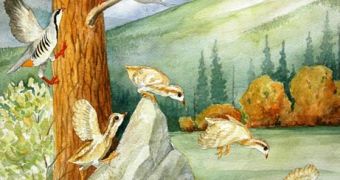Birds are the only living dinosaurs, and the transition from hatchling to adult appears to be like a transition from flightless dinosaurs to flying dinosaurs. A new research published in "Nature" reveals how young birds must control the wing angles in order to achieve flying.
The team led by Kenneth Dial of the University of Montana has shown how birds can run up vertical trees, boulders, or cliffs using their wings to make a wind force that maintains them to the surface; this could be done even by young birds using their small undeveloped wings. Hatchlings can run up 60-degree slopes, an essential ability during the vulnerable period before they can fly, as revealed by the researches made on chukars, partridges that live in Western Asia.
"It has profound implications that an [undeveloped wing] has a function shortly after hatching for many birds," Dial explained.
Now, the team has found that this ability is given by learning the optimal wing-to-ground angle required to generate force, which is the same for chicks and adults, using it to get to the flight level.
"Birds use [undeveloped wings] to improve their locomotive performance and escape predators," said Dial.
"[birds] are always going 'up and forward' in some sense, whether flying or running up trees, and so the angle of attack of the wings is sensibly the same, or nearly so," said Kevin Padian, an expert on the origins of flight at the University of California, Berkeley.
"Chukars really only need one wing stroke, and they use [their wings] the day they hatch in an aerodynamically meaningfully way-even though they can't fly. The way in which vulnerable young birds use their wings while transitioning into adult bodies could be a model for how their ancestors developed the ability to fly. When you step back and look at the fossils they are finding, the long-legged dinosaurs with half a wing, they look very uncannily like today's birds that are going through the juvenile stage. When you look at the development of these animals, you may in fact be looking at the strategies that their ancestors employed to get through transitional states [in evolution]," Dial added.
Two theories have been trying to explain flight origin: the arboreal theory (bird ancestors leaped from the trees, glided, and then flew from branch to branch; and the cursorial theory, of running protobirds taking off the ground.
"This really says that flapping baby wings is more likely the explanation for the evolution of flight. There is no reason you have to start off talking about ground 'up' or tree 'down'," said Dial.
"The arboreal-cursorial dichotomy is dead and has been for a long time. It's a question of how the flight stroke evolved. Many things live in trees, and even glide, but never truly fly (flap)," added Pardian.

 14 DAY TRIAL //
14 DAY TRIAL //